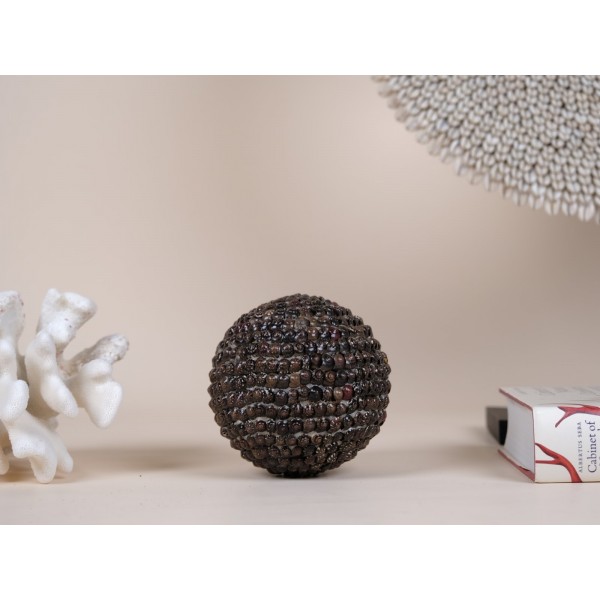Giant Triton - Charonia tritonis
Giant Triton, in shell length - this is one of the biggest mollusks in the coral reef.
Great quality (F+/ F++), with beautiful pattern and colors, very hard to get in this size nowadays - from Madagascar.
| close |
This shop uses cookies to improve your experience on our website. |
Reference: N1055
A beautiful Shell ball made with Umbonium vestiarium shells, from Indonesia.
These balls are part of the Indo-Pacific cultural heritage, and from a long time tribal people use them as adornment pieces. Today they are natural and beautiful decor pieces.
Dimensions: 10 cm diameter
Weight: 184 g

A beautiful Shell ball made with Umbonium vestiarium shells, from Indonesia.
These balls are part of the Indo-Pacific cultural heritage, and from a long time tribal people use them as adornment pieces. Today they are natural and beautiful decor pieces.
Giant Triton, in shell length - this is one of the biggest mollusks in the coral reef.
Great quality (F+/ F++), with beautiful pattern and colors, very hard to get in this size nowadays - from Madagascar.
Four cutted and polished Nautilus pompilius in a glass vitrine with golden lacquered wood base, designed by One of a Kind.
Supplied with certification document.
One of a Kind decor piece!
A giant size glass dome with a selection of nine superb Spondylus.
One Spondylus regius from Philippines, three Spondylus americanus from Brazil, one Spondylus gloriosus visayensis from Philippines, one Spondylus aurantius from Philippines, one Spondylus varius from Philippines and two Spondylus ictericus from Brazil.
Unique One of a Kind decor piece!
Vertical branch black Gorgonian in a black lacquered wood base, these medium sizes Gorgonia have a special shape and are taken by divers from Manado, North Sulawezi - Indonesia.
A unique big glass vitrine with a massive black lacquered wood base. Displaying an exceptional selection of three Haliotis cracherodi polished, showing its colors and patterns, from Baja California - USA, three Haliotis midae polished with the usual bronze colors and dramatic pattern, from R.S.A. and two Haliotis rubra with great mother-of-pearl shinning from South Australia.
Handmade One of a Kind piece!
A superb polished Haliotis assimilis tray table in satin brass. Look like a Victorian table piece.
With six Haliotis shells polished on both sides, ideal for bringing nuts or sweets to the table.
Unique One of a Kind design piece.
Superb pair of Hexaplex cichoreus from Balicasag, Philippines.
This intricated species is very variable in pattern and color, along the years we have had exceptional pieces, these ones are of great beauty.
Mounted in a black lacquered wood base.
Sponge species from Madagascar reefs, mounted in a black lacquered wood base.
Sponges are beautiful decor items, due to its different shapes and colours.
Four Spondylus imperialis in a black wood glass frame.
Beautiful specimen collected by divers in 20 m deep of Jetafe, Bohol Isl. - Philippines
Turbo marmoratus, from Indonesia, mounted in a handmade work in brass.
Known as the Green Turban, the Marbled Turban or Great Green Turban, is a large species of marine gastropod with a thick calcareous operculum in the family Turbinidae, the turban snails. The shells of these large sea snails have a very thick layer of nacre; this species has been commercially fished as a source of mother of pearl.
One of a Kind decor piece!
Glass dome with five Pleurotomaria hirasei.
This deep water shell was a huge rarity 20 years ago and much sought after by collectors!
Recently have been found in big quantities in South China Sea. A classic and a beautiful shell!
A beautiful glass dome with small Gorgonia from de Indo-Pacific, 3 corals Montipora sp., 6 Conus betulinus and 3 Conus figulinus all from Philippines.
Combined shapes and colours make this glass dome a beautiful decor piece.
This species of Spongia came from the Florida Keys.
It is a very healthy population once from many years they are fished commercially for bath sponges, these are special pieces turned into great decor objects. The sponges feed on microorganisms that they filter and their larvae are taken by the sea movements making them widespread. Taken by divers from 5 to 40 meters deep.
Mounted in a black lacquered wood stand.
This stunning large Victorian-style glass dome showcases an exquisite collection of meticulously selected marine specimens, each with its own unique story. The arrangement features:
A Montipora sp. coral from the Solomon Islands, known for its intricate structure and natural beauty.
A striking black gorgonian coral from Indonesia, adding dramatic elegance to the display.
A superb Dardanus megistos hermit crab, housed in a Tonna perdix shell, from Palawan Island, Philippines.
A rare Pleucocidaris verticillata sea urchin from Bohol Island, Philippines, with its distinctive spiny form.
A remarkable brittle star, Ophiolepis superba, from Sandigan Island, Philippines.
Three vivid Clanculus puniceus shells from Palawan Island, Philippines, with their vibrant, intricate patterns.
A delicate Argonauta hians (paper nautilus) from Indonesia, a true marvel of the ocean.
Beautifully curated and arranged, this dome captures the elegance and diversity of marine life, making it a truly unique and sophisticated centerpiece for any interior
This Elisella specimen in a red flame form is a rare species of gorgonian from Leptogorgia family, found in the coast of Broome, Northwestern Australia.
Gorgons, like corals, are animals living in the form of sessile colonial polyps, organized in a tree structure. The general structure, a skeleton both flexible and hard, called gorgonin does not grow towards the sun - it does not require light to develop -, but perpendicular to the current, to filter a maximum of water flow.
These are beautiful colored specimens!
A beautiful Shell ball made with Umbonium vestiarium shells, from Indonesia.
These balls are part of the Indo-Pacific cultural heritage, and from a long time tribal people use them as adornment pieces. Today they are natural and beautiful decor pieces.